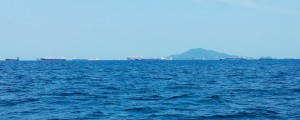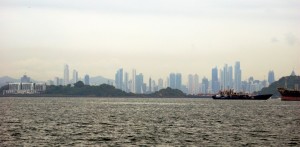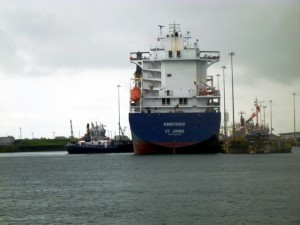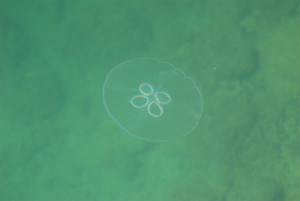Panama Canal crossing
May 24th – May 29th: Isla Contadora to Taboga Island
We first went to the moorings at Taboga Island. Our friends from Neko had called both marinas and the Balboa Yacht Club off of Panama City, and all said that they had no space available. We decided to join them at Taboga, which did have available moorings. Taboga is about ten miles from the canal entrance in Balboa, and we had read about ferry service from the island to Balboa, so we figured we could go into the city for provisions and supplies. The run from Contadora was very smooth, with a favorable current. We covered the thirty-four miles in about five hours. The moorings are run by an expat cruiser named Chuy. The moorings are strong and well-maintained. We thought that the island would have restaurants, stores, and wi-fi. Well, it had a restaurant that was open every day (a few more were open on the weekends), a store that was never open, and wi-fi that wasn’t strong enough to make a data connection.
Position at destination: 8°48’ N, 79°33’ W
Air temp: 87, Water temp: 86
Nautical miles for this leg: 34 Total: 4461
Departed at 8:45am, arrived at 2:00pm
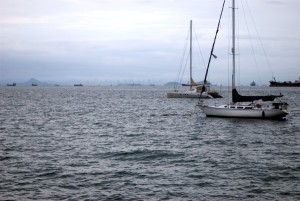
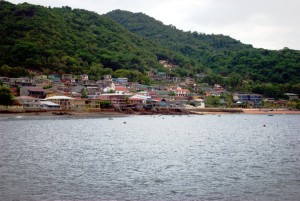
Taboga Island moorings Taboga town
Regardless, Taboga is a very pretty place with a colorful village. On Sunday morning, we decided to take the ferry to Balboa. There is a “fast” ferry that takes thirty minutes to Balboa for $8, or a “slow” ferry that takes an hour to get to Las Brisas for $7. The fast ferry resembles a big panga that has a fiberglass shell over it, with open windows and rows of seats, and three 250hp outboards. This ferry has two daily round trips, departing Taboga at 9:00, and returning at 3:00. The slow ferry only has one daily trip, leaving Las Brisas in the morning and returning in the afternoon. Both of them have expanded service on the weekends. We elected to take the fast ferry, and Chuy gave us a lift to the dock. We arrived at the Balboa Yacht Club pier and took a taxi to Albrook Mall. This is a very modern US-style mall primarily aimed at upper-class shoppers. It’s very close to Balboa, and it does have a grocery store in it (Super 99). Given the short amount of time we had before the return trip, this made sense for the day.
We arrived at a little after 10:00, but the mall itself didn’t open until 10:30. There was a department store: Arrocha, which had an open outside entrance. We discovered a large stash of Fancy Feast cat food for Quincy, but decided not to buy it pending a visit to Melo, which we had been told was a large pet supply store. We did buy a few odds and ends at Arrocha, and then went into the mall. Unlike the Arrocha, the air conditioning in the mall wasn’t so good, especially on the upper floor. We checked at a Digicell store to see if we could get an Internet card, but they told us they didn’t sell pre-paid ones, so that was out. Eventually we found the Melo store, and it was pretty disappointing – quite small and very little cat food. They had more stuff for birds than cats, but we scored some Fancy Feast, and tried out another brand they had that looked likely. We then went to Super 99, which was a large modern grocery store with a wide selection of products that weren’t Mexico cheap, but a lot less than Costa Rica. We took a taxi back to the BYC for $3, and then caught the return ferry. Turns out that Quincy had no interest in the different brand…
On Monday we went to the City again, along with Mary and Peter, who had to check in to the country. There are three chandleries at the end of the Amador causeway, and Peter and Mary had to go the Flamenco to check in, so we shared a taxi with them. The Centro Marine store had the best selection, so we bought a few items and then asked about La Casa de Baterias, seeking our new 8D batteries. They have a lot of stores in the City, and a guy at the chandlery advised us to go to the branch in Paitilla district. The taxi driver knew just where to go, but it was confusing to us: it was in an underground parking garage. We walked through the garage, following the signs, and sure enough, it was there. Unfortunately, so one in the store spoke English, and I did my best to communicate what we needed. They had a couple of 8D batteries, but they weren’t AGM. Apparently, the majority of their business is automotive batteries, hence the parking garage locale. I did my best to ask in Spanish if another store had the AGM batteries, and they made a call to another location. They said there was one at a different location, but they wouldn’t deliver it to this location, or to Colon, which is where we would want to install them. So, we gave up, and decided to order the batteries through Marine Warehouse, a Florida-based operation that has offices in Panama. This was strike one.
The next stop on our agenda was PeDeSu, or Pet Supply Depot. I had found their website, which showed pictures of the pearl cat litter we had been using. The site listed a store in the Colon Free Zone as well as one in Panama City. I pulled up the location on our phone, since there don’t seem to be many actual street addresses in the city. The second taxi driver we asked seem to have an idea where it was. He got us to the neighborhood and the street, but no store was visible. I had the map active on the phone, and we were right where the store location was indicated. After a fruitless search, I called the store, and the driver spoke to them in Spanish. After some time, he handed the phone back to me, and I was able to have an English conversation with someone. I was asked where I came from, which didn’t make much sense to me. I said I was in Panama City, and again I was asked where I came from. I decided to play the game, and said I was from San Francisco. Then she asked me if I was selling something. I said no, that we wanted to buy something at their store. Then she said they only have a store in Colon. I asked her why the website showed a store in Panama City, but then she suddenly stopped speaking English – strike two.
Our next stop was Price Smart, which is very similar to Costco, and was split from the original Price Smart, which became Costco. This chain has stores throughout the Caribbean, including two in Panama City. Like Costco, it’s a membership club, so we planned to buy the membership for $35. We got to the store and started the membership process, only to be stopped when we didn’t have valid ID. We only had our California driver’s licenses, which aren’t considered legal ID in Panama. This was strange, since I had used my license as ID at the Albrook mall the day before. There was a guy there translating for us, but to no avail – they wouldn’t budge – strike three. We picked up the application and planned to return the next day.
By now it was about lunch time, so we decided to find a restaurant. That’s when we discovered that Panama City is nothing like Mexico, El Salvador, or Costa Rica, when it comes to restaurants. They are hard to find here. We wandered for a while before coming to a cafeteria-style joint, which seems to be the ubiquitous lunch restaurant style here. Not interested, we kept looking, and we found a chain that has steaks and Italian food. We wanted to get some pasta, but after a difficult conversation, we figured out that this place only had steaks, despite all of the Italian food on the menu. We started walking again, and came to another cafeteria, where we gave in and had a decent and cheap lunch. The lunch experience felt like strike four.
We still had a couple of hours to go before the ferry departure time, so we decided to walk over to the Abernathy chandlery at Transmistica, which we had been told was a very large store. The walk seemed to be about seven or so blocks, and we just hoped that they weren’t Mexican blocks. When the sun was on us, it was intolerably hot, and we started to question our sanity. We did get to the store, which blessedly had a large fan in the front, so we were able to cool down a bit. As for the store, it was 80% fishing gear, so we struck out again. Is there a league where you get five strikes? We finally gave up, and went back to the Balboa Yacht Club for drinks before catching the ferry.
Once there, we saw Peter and Mary. They had completed their check-in without too much trouble, although they did have to go to an immigration office in Albrook to get their $105 tourist visas. We didn’t recall that – our immigration check in cost $25. Eventually we figured out that we would have to get these, which are required if you arrive by boat. I have no idea why the Immigration Officer in Armuelles didn’t get this done for us. Before leaving, Peter checked with the BYC office, and they said that he could get a mooring the next day. Apparently, asking in person works much better than on the phone. Anyway, we took the ferry back, had more drinks, and mulled over our five-strike day. We asked Chuy to give us a ride to the dock the next morning so we could finish our Price Smart membership.
For the third day in a row, we took the fast ferry to Balboa. The first thing we wanted to do was to get our tourist visas. Peter and Mary had given us the number of the taxi driver who took them to the immigration office, as it apparently was new, and not so well known. We didn’t want to have to wait for him, and we figured we could just tell a driver to take us to Migracion at Albrook – how hard could that be? We flagged down a taxi, and asked to go to Migracion at Albrook. The driver seemed a little confused, but asked us to get in. Then the debate began – he asked if we wanted to go to Diablo or the main office – we said Albrook. He asked some people on the street, as he didn’t seem to know about the office at Albrook. Neko had told us the office was close to the Albrook Airport (small airport for mostly domestic flights), so I guessed that the office must be at the airport. I asked the driver to take us to the airport, which is very close to the Albrook Mall. When we got to the airport, the traffic was stopped by construction. We got tired of waiting, so we got out and asked where we could find Migracion. As luck would have it, this was the building! We went inside to the office and then asked the officer if we could get our tourist visas. She had no idea what we were talking about, and asked some other offices, and made some phone calls. I showed here the stamps in our passports, said that we needed tourist visas, and she still had no idea why we were there. I decided to call our agent, Roy Bravo, to have him explain. He was surprised that we were trying to get these, and he told me that he would take care of it for us. He talked with the office, and then we left – this had to be strike six.
We decided to take a short taxi ride to the mall, going to Arrocha for more cat food. After that, we went to Price Smart, where amazingly enough, we completed the membership process. The store was quite similar to a Costco, carrying some Kirkland brand products, and having the same hot dog and pizza deals that you find in Costco’s. We checked out the store thoroughly, and I was delighted to find beer cheaper than soda – a case of Balboa was $12! We didn’t want to get too much stuff, since we had to take the ferry and Chuy’s little dinghy, so we bought as much as we could hand carry in a single load. We noticed that the food outlet also had fried chicken, which is one of Quincy’s favorites, so we bought a box before we left. When we got back on board, he sniffed out the chicken, and was on the table trying to open the box while we were still bringing in the groceries! Before we left the BYC, I checked with the office, and like Neko, we were told that we could come over the next day. We had to do this since we had to be measured for our crossing at La Playita at the end of the Amador Causeway.
May 29th: Taboga Island to Balboa (Panama City)
We left the following morning for BYC, navigating through the many, many moored ships in the Bay. They are a combination of ships waiting for the canal transit and some bunker oil carriers – there was even a sunken one with half of its hull visible. We contacted Flamenco station for permission to enter the shipping lane and proceeded to BYC, where we tied up in the middle of the field, with sailboats very close, fore and aft.
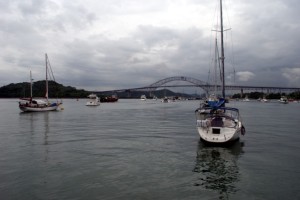
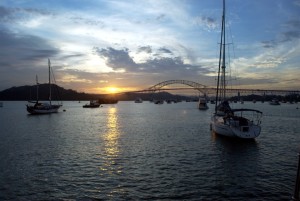
Daylight and sunset views of the canal entrance from our bow
For the afternoon, we went back to Price Smart, where we ran into Peter and Mary from Neko. Since cabs were hard to find leaving Price Smart, we shared the one that had been waiting for us. It was totally stuffed between the groceries and ourselves. When we returned to BYC, we were met by some guys that had carts to take our goods out to the launch dock. It’s a long, steep ramp down the hill, with a lot of cracks and bumps, so we were happy to have the service. The guys asked for $10, which we thought was worth it. We called our canal agent, Roy, and he said that we could be measured from our crossing on Friday, but that we would have to take the boat out to La Playita. Apparently the ACP boats won’t drop off at the BYC pier, which seemed ridiculous to us, as those boats are coming and going all day at the pier. In any event, it was only a couple of miles to the anchorage. We were given a time window of 9:00 to 1:00. We arrived at the anchorage, which was relatively busy. We quickly discovered that it was quite rolly, with the wakes from the ACP boats coming from all directions. This made us glad that we are the BYC moorings, where we rarely felt the roll, despite the many ACP boats, ships, and ferries coming at all times of the day and night.
Around 10:00, a big ACP boat came alongside us carrying the canal’s inspector. I really don’t know why they insist on using the big boats, as it is quite difficult for the inspectors to get off and on, especially for smaller sailboats. The driver was very talented, but it took three approaches to get the inspector onto our boat. The measurement went quick and easy, but every inch of the boat is taken into account. Our bowsprit and swim platform were considered in the length, but we were still less than the magical fifty feet, where the rate goes up significantly. The inspector told us that one wooden sailboat owner actually sawed his bowsprit off to get under fifty feet.
Later that afternoon we met Roy at the BYC restaurant. He said that we could transit on Tuesday, and that he would bring us the lines and tires on Monday, and take our passports to get the tourist visas. With the clock ticking, we decided to make one more provisioning trip to Price Smart, as well as another trip to Melo for pet food. We decided to go on Sunday morning, stopping from brunch at the dim sum at the Lung Fung Restaurant, touted in the cruising guide. When we got to the restaurant, it was a mob scene and very confusing. There were at least three floors, and we couldn’t figure out the differences, so we went to the one that would seat us right away. I had expected this to be a conventional dim sum, with lots of carts coming around to choose from. But there were very few carts – most patrons seemed to be ordering from direct from the kitchen. No one on the staff spoke English – it was Chinese or Spanish. We ended up getting just a smattering of food, and decided to move on to Price Smart. We walked the ¾ mile, and observed that on Sunday, virtually every store in the city is closed. We completed our provisioning and headed back by taxi to BYC. Once there, we discovered that on Sunday, the guys with the carts aren’t there – and all of their carts are locked to the chain fence. We found one very heavy cart that wasn’t locked, but there was no way that we could control it going down the hill. We started to ferry the bags down the hill, and the guard at the pier entrance told us that we could use one of the carts from the small boat yard there, with one of their guys helping us. So we just had to take the goods down the hill.
On Monday, we gave our passports to Roy for the visas, and waited for him to come back in the afternoon with our passports, lines, and tires. He came on board around 4:30, and told us that a boat was coming through the opposite direction, and it would drop off the tires and lines. We saw the boat come, and we watched it go. Roy called them (they were Italian) and they said that the advisor wanted to get dropped off at La Playita first. Apparently the people on that boat wanted to drop off the lines in La Playita as well, but Roy told them that they would have to use (i.e. pay) the dinghy dock there, so they decided to return to BYC. After another half an hour or so, they did come back, and Roy used a BYC launch to get them. I have to say that 125’ lines are really big, as they are thick. We got a dozen tires as well, so our cockpit was full. Our passage was set for first thing in the morning, so he would bring the line handlers on board at 6:15, and we would pick up our advisor at La Playita at 6:45. We were glad to have an early start, to guarantee that we could get through in one day.
For our last night, Peter and Mary suggested that we go out with them to dinner in the Casco Viejo district, which dates back to 1671. There are lots of very old churches, plazas, and buildings, with many al fresco restaurants on the narrow streets. Some people say it resembles the French Quarter in New Orleans, and it did remind us of Paris somewhat. We ate at an Italian restaurant called Segafredo, and the food was quite good. After dinner we wanted some ice cream, but the store we had in mind was closed, so it was back to the BYC.
June 3rd: Panama Canal crossing, Balboa to Shelter Bay Marina
We got up at 5:45 to prepare for our crossing. Roy was a little late, arriving with the line handlers at around 6:15, but our schedule had already been delayed to 7:45 at La Playita. He introduced us to the line handlers – Rick, Daniel, and Norberto. Roy suggested three handlers – if we needed a fourth, Rosé could take that role.
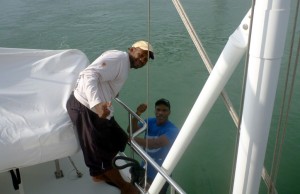
Rick and Daniel setting up for the transit
When you cross the canal, you are required to provide food for the line handlers and the advisor, so Rosé made a pancake breakfast. The guys had very healthy appetites; consuming six pancakes each, with no syrup. Apparently the local custom is to just have buttered hotcakes. I was too nervous to eat, after reading enough horror stories of turbulence and wakes in the locks. After breakfast, the guys strung up the tires, fenders and lines. Flamenco station called us on the VHF at 7:45 to tell us that we could meet our advisor in the ship channel just outside of BYC (so we didn’t need to go to La Playita after all).
We eased out to the channel when our advisor arrived on one of the big ACP boats. His name was Carlos Bemavides, and he normally operates dredges for the canal, acting as an advisor to small yachts on his day off. He was very competent, knowledgeable, and friendly. He told us to wait just outside the channel for the ship that we would be locking with. The schedule had us going through with a tour boat, the Isla Morada. This small ship, once owned by Al Capone, takes guests from Panama City through the Pacific locks to Gamboa. The plan was for us to tie to the Isla Morada, which would be tying to the canal side wall. We liked this plan, as we would have an easier time with lines. We would be following one of the big (really big) car carriers, the Pyxis. Our schedule:
The schedule was very optimistic. At our measurement, we stated that our top speed was 8 knots, with a cruising speed of 6.5 knots. I saw that he entered both speeds, but the paper the advisor showed me only had the 8 knot top speed on it. He told us that normally, a boat needs to arrive at the Gatun Locks by 3:00PM to complete a one-day transit. We hoped that we would be on time, and that we could have some wiggle room on the Gatun Locks arrival time.
A little before 8:00AM, the Pixys passed us on its way to the canal, and we fell in behind it a quarter of a mile or so. It was going quite slow, at 3.5 knots, so we followed at close to idle. As we passed underneath the Bridge of the Americas, it came to a halt. It would continue to crawl towards the Miraflores lock, and we could do nothing but wait. In this area, the new locks under construction can be easily seen to the left side of the canal. The new locks will allow much wider and longer ships to use the canal, but the construction seems to be very much delayed. While transiting this area, the Isla Madora passed us to get behind the Pixys.
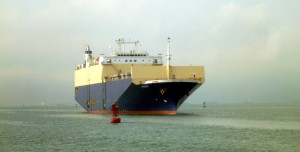
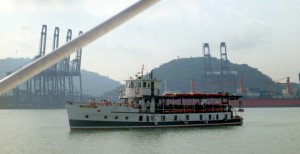 Pixys entering the canal Al Capone’s boat, the Isla Madora
Pixys entering the canal Al Capone’s boat, the Isla Madora
After what felt like an eternity, we finally saw the Miraflores Locks, but we were holding well short of them. We could see a ship entering the right hand lane, where we were scheduled to go. After drifting around for some time, we were told that we would be using the left hand lanes, and we saw the Pixys approaching the entrance guide wall on the left hand lane. This is where the big ships get lined up to enter the canal. The mules, or locomotives, don’t actually pull the ships through the canal – they maintain its center position. With a Panamax vessel like Pixys, this is very important. The lock is 100’ wide, and the Pixys has a 106’ beam. You can see just how close it is with this picture.
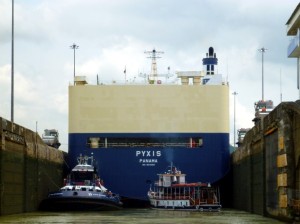
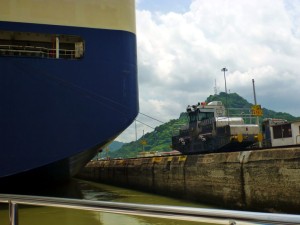
Pixys completely filled the lock “Mule” keeping Pixys centered in the lock
There wasn’t much to do as the Pixys was getting aligned – it was a relaxing time. The sun was out, and it was really hot, but the bimini provided enough shade to make it tolerable.
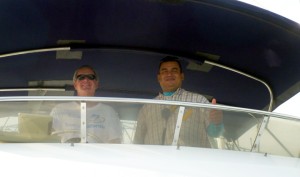
Lucky and Carlos relaxing outside of the lock
Once Pixys moved into the first chamber, an ACP tug tied to the wall behind them, followed by Isla Madora, which tied to the wall just aft of the tug. We were then given the all clear from the Isla Madora’s advisor to tie up. I eased the Tropical Blend alongside, and the line handlers worked their magic to get us safely into position. There were a lot of American tourists on the Isla Madora, and they w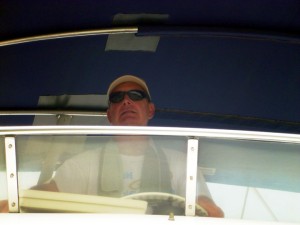 ere fascinated with the Tropical Blend next to them, asking us questions about our voyage. The lock doors closed, and we could tell from the turbulence that we were being raised. It takes about eight minutes to fill the lock, which raised us by twenty-seven feet per chamber (two of them). Once the lock was full, the Pixys departed with a huge amount of propeller turbulence, then the ACP tug left, and then we untied from the Isla Madora. We moved ahead, and I discovered that there was a tremendous amount of turbulence present, forcing me to saw on the wheel quite a bit.
ere fascinated with the Tropical Blend next to them, asking us questions about our voyage. The lock doors closed, and we could tell from the turbulence that we were being raised. It takes about eight minutes to fill the lock, which raised us by twenty-seven feet per chamber (two of them). Once the lock was full, the Pixys departed with a huge amount of propeller turbulence, then the ACP tug left, and then we untied from the Isla Madora. We moved ahead, and I discovered that there was a tremendous amount of turbulence present, forcing me to saw on the wheel quite a bit.
I can’t overstate the trouble keeping the boat straight through the locks – I can imagine that smaller boats have a big problem with this. The Isla Madora passed us, and we heard their adviser requesting to side-tie to the tug in the next lock. They almost hit the wall with their bowsprit, so they didn’t want to do that again. The new plan was for them to tie to the tug, and we would slot in behind them and tie to the wall, which I wasn’t too crazy about, but I trusted that Rick and his team would keep us safe. Once the tug and Isla Madora were in place, we proceeded into the second chamber, but it was obvious there wasn’t enough room behind them for us to tie to the wall. Apparently the tug had left more space between them and the Pixys this time. Carlos contacted the other boat’s adviser, and we agreed that we would side tie to the Isla Madora. Since it is a fairly narrow boat, there was plenty of room. However, just as I was approaching them to our port side, their stern veered to starboard hard, which took me by surprise. Once they settled in place again, we tied up to them without problems. After tying up, the lock filled and we were released after the Pixys. Again the turbulence caused me a lot of problems maintainin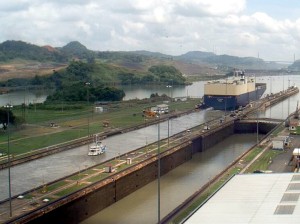 g course, but this time I could use more power to get us into Miraflores Lake, which separates the Miraflores Locks from the Pedro Miguel Locks. This lake has the dredge where Carlos normally works. There is a webcam at the Miraflores lock. As we passed through the exit lane, our friend Kurt from Endurance was watching, and sent us some screen captures. You can see the entrance for the new lock at the left.
g course, but this time I could use more power to get us into Miraflores Lake, which separates the Miraflores Locks from the Pedro Miguel Locks. This lake has the dredge where Carlos normally works. There is a webcam at the Miraflores lock. As we passed through the exit lane, our friend Kurt from Endurance was watching, and sent us some screen captures. You can see the entrance for the new lock at the left.
We entered the lake and waited for the Pixys, the ACP tug, and the Isla Madora to pass by. Once again, the Pixys took a really long time at the guide wall, so we knew we were running quite late. Finally it was in the lock, and the lineup started again.
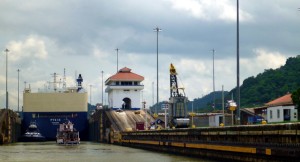
Entering the Pedro Miguel lock
This lock raised us up by thirty-one feet, a little more than the Miraflores chambers. Once again it was easy to tie up with our expert line handlers, and the turbulence was minimal. After waiting eight minute, we were raised to the height of fresh-water Gatun Lake, eighty-five feet. This year is the one-hundredth anniversary of the opening of the canal, and we had a fifth “passenger” in the lock – but I don’t think it paid a toll!
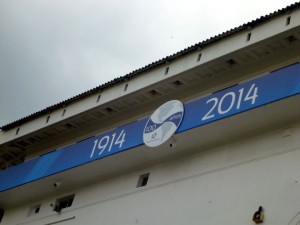
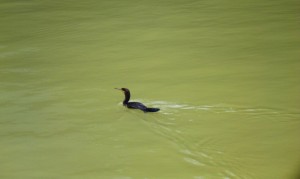
100th Anniversary of the canal This bird locked up for free
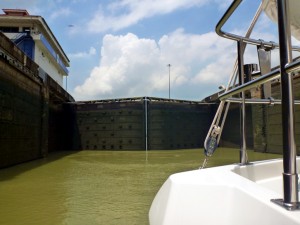 It was still sunny at this point, and the heat was really getting to me – I was soaked, so I put on the so-called “cool towel” I had bought in Panama City. It’s hard to say if it really works, but I did like to cool feel of it against my skin. Once you are tied up in the lock, you can take time to marvel at how 100-year old technology has held up. Rosé said that we can’t build bridges to last 50 years, but this canal with relatively primitive technology is still going strong.
It was still sunny at this point, and the heat was really getting to me – I was soaked, so I put on the so-called “cool towel” I had bought in Panama City. It’s hard to say if it really works, but I did like to cool feel of it against my skin. Once you are tied up in the lock, you can take time to marvel at how 100-year old technology has held up. Rosé said that we can’t build bridges to last 50 years, but this canal with relatively primitive technology is still going strong.
 You might wonder how Quincy was handling the transit. Well, for him it was just another day. He didn’t care about the strangers on board, the noise, the activity, or the turbulence. He was looking to eat as usual, took care of business when he had too, and even ventured outside a bit to see what all of the fuss was about. In between, it was naptime.
You might wonder how Quincy was handling the transit. Well, for him it was just another day. He didn’t care about the strangers on board, the noise, the activity, or the turbulence. He was looking to eat as usual, took care of business when he had too, and even ventured outside a bit to see what all of the fuss was about. In between, it was naptime.
Once we were raised to the top, we heard the tug call the pilot on the Pixys, and asked them to go easy on the thrust when departing. I think this is why they tied further back in the second Miraflores chamber. You have to see the turbulence caused by these ships to believe it. The Pixys did indeed depart more smoothly, and we were then released. Carlos told me to give it as much as I could, and we passed by the Pixys and the tug.
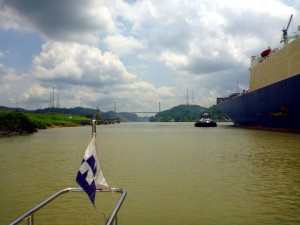
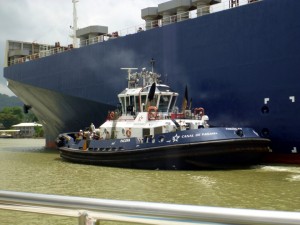 Exiting the Pedro Miguel lock ACP canal tug
Exiting the Pedro Miguel lock ACP canal tug
We were now clear to proceed at best speed, since we were running about an hour behind schedule. We were supposed to be out of the Pacific locks by 11:36, and it was already 12:30, and there was no way that we could sustain more than 8 knots. Like most Nordhavns, Tropical Blend has a keel cooler and dry exhaust, so the engine is cooled by circulating the coolant through a radiator on the hull of the boat. Since the surrounding water here is so warm (close to 90°F) we don’t get a tremendous amount of cooling. The maximum rpm for our engine is about 2300, but sustained operation at that speed will cause the temperature alarm to sound. It’s set for 205°. The engine isn’t harmed at that temperature, but the alarm is loud, and you don’t want to push it too hard. I found that we could run at about 2050 rpm’s without tripping the alarm. We were making about 7.7 knots at that rpm, so it was clear that we couldn’t be at the Gatun Locks by 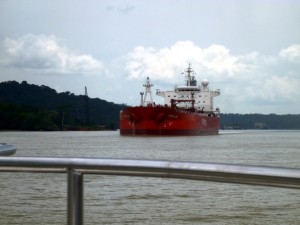 3:00. However, Carlos said that there are often delays, so push as hard as we could. We entered the Culebra Cut, also known as the Gaillard Cut, where the digging was very tough due to the rocky nature of the mountain. This area is rather narrow, so traffic for the big ships is primarily one-way. Pixys was the last northbound ship until 8:30 that night, so we would see a steady stream of southbound traffic. Rose served up a lunch of sandwiches, chips, and apples (and the crew ate two each), and then the rain started to fall. It rained for the rest of the day, so we couldn’t take many decent pictures.
3:00. However, Carlos said that there are often delays, so push as hard as we could. We entered the Culebra Cut, also known as the Gaillard Cut, where the digging was very tough due to the rocky nature of the mountain. This area is rather narrow, so traffic for the big ships is primarily one-way. Pixys was the last northbound ship until 8:30 that night, so we would see a steady stream of southbound traffic. Rose served up a lunch of sandwiches, chips, and apples (and the crew ate two each), and then the rain started to fall. It rained for the rest of the day, so we couldn’t take many decent pictures.
As we passed through Gamboa before entering Gatun Lake, Carlos pointed out a very large 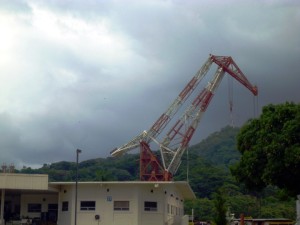 crane that is used to lift the canal doors for maintenance. This crane was originally commissioned by Adolf Hitler for Nazi Germany, and the US seized it during the Second World War. It was in Long Beach until 1996 when the canal authority bought it. Carlos said it still has a swastika on it, so I nicknamed it Hitler’s Crane.
crane that is used to lift the canal doors for maintenance. This crane was originally commissioned by Adolf Hitler for Nazi Germany, and the US seized it during the Second World War. It was in Long Beach until 1996 when the canal authority bought it. Carlos said it still has a swastika on it, so I nicknamed it Hitler’s Crane.
We continued past Gamboa and into Gatun Lake, with a steady stream of car carriers, container ships, freighters, and tankers coming in the opposite direction. As we entered the lake, the rain intensified, driving me out of the flying bridge. Our crew had a relaxing afternoon – I was able to tune in the Panama – Brazil friendly football game, which they enjoyed watching despite the 3-0 shutout by Brazil. Daniel, a carpenter by trade, worked to improve our galley drawer under the stove, attempting to get it in working order.

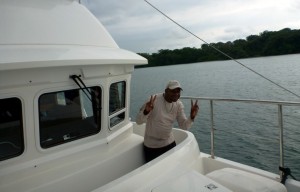
Easy going crossing Gatun Lake Rick was working hard
We continued to monitor the time, and it was looking less and less likely that we could get this passage done in one day. When we got to the far side of the lake, we looked at the AIS display for the lock entrance to see several ships still waiting, so we had some hope. When we were about eight miles out, we could see that the last ship was starting to move towards the locks. As we got closer, Carlos called to ask the status at the Gatun Locks, and we found out that there were delays there. He told them that we could be there in fifteen minute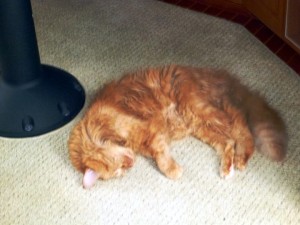 s, but we were at least thirty minutes away. At this time, I gunned the engine and put tape over the alarm to quiet it down. I manually monitored the coolant temperature using the IR gun, and it was at 208°, so we were OK. Once we got within visual range, we could see that last ship still at the guide wall. It was the Kingfisher, which had been scheduled to enter the lock at 2:30 with us. Thank heavens for delays! Quincy wasn’t too concerned about the delays.
s, but we were at least thirty minutes away. At this time, I gunned the engine and put tape over the alarm to quiet it down. I manually monitored the coolant temperature using the IR gun, and it was at 208°, so we were OK. Once we got within visual range, we could see that last ship still at the guide wall. It was the Kingfisher, which had been scheduled to enter the lock at 2:30 with us. Thank heavens for delays! Quincy wasn’t too concerned about the delays.
By now the rain had stopped, and we pulled forward of the Kingfisher, holding at the lock entrance. We were going to side-tie to the tug going through ahead of Kingfisher. This ship wasn’t nearly as large as Pixys, with a length of 546’ and a beam of “just” 91’, so there would be more room in the lock, and the passage would be faster.
As we waited we could see that that the mules still weren’t back to the Kingfisher, so we didn’t have to push so hard. After waiting about twenty minutes, we were cleared to go ahead and tie up to the tug. The rain had started again, getting harder by the minute. Carlos told me that while it wasn’t required, it might be helpful to offer the crew of the tug sodas and snacks. I passed this on to Rosé, and she delivered sodas and cookies. This turned out to be very helpful, as the tug passed us in the lock very gently. Later at Shelter Bay, we talked with a sailboat owner whose boat had been knocked into the wall by the side thrust of a passing tug – he didn’t know about the power of bribes!
We entered the lock at 4:30, two hours late, and feeling very lucky. We tied to the tug, watched Kingfisher follow us in, and saw the lock filling up. As the guide books predicted, locking down is a lot less turbulent than locking up, but I still had to saw the wheel a lot in the lock. The crew on the tug was very careful with us, thanks in part to the snacks.
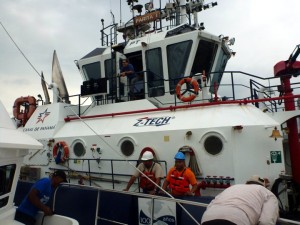
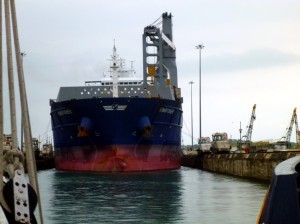
Tying up to the ACP tugboat The Kingfisher following us into the lock
The rain continued to intensify as we transitioned through the locks. By the time we were in the final lock, the windows inside the pilothouse were steaming up. Since we don’t have a defroster, we used a large fan to clear off the windows. We cleared the final lock, but couldn’t see much because of the rain and the failing light. By now it was around 6:00PM, and we proceeded down the channel towards Cristobal, where we would drop Carlos off in the “Flats” before crossing over to Shelter Bay. Carlos advised me to pull over to allow Kingfisher to pass, but just as I did, they stopped to drop off their pilot, so we had some more delay. Finally we got to the flats, dropped off Carlos, and radioed Cristobal Control for permission to cross the bay. We reached Shelter Bay Marina to get our slip assignment, and John Halley, the marina manager, said he would meet us at the slip. We spotted the entrance lights and pulled in very slowly, as it was now full on dark with a heavy driving rain. Our slip was the second one on the finger, a double slip with no other boat, so even without a bow thruster it was easy to get in. Unfortunately, the slips here are very wide, but they have very short fingers, so we couldn’t get off the boat. We decided to turn around and go stern in, which wasn’t the easiest thing in the world to do in the dark and rain, with no bow thruster, With the help of John and our line handlers, we got into the slip, and were welcomed to the Caribbean. No tides, no surge, and clear water – what more could we ask for?
Position at destination: 9°22’ N, 79°57’ W
Air temp: 86, Water temp: 85
Nautical miles for this leg: 42 Total: 4509
Departed at 7:45am, arrived at 7:00pm
June 2014: Shelter Bay Marina
The next day we checked in to the marina. We were planning to spend a couple of weeks here before heading to Bocas del Toro, 120 miles north, and then to the San Blas Islands before going to Cartagena, Columbia. Shelter Bay Marina is a growing place, and they were adding new docks to enlarge capacity. Most of the boats here are not occupied, but left for the summer as this is a no-hurricane zone. The marina was fairly full, but we had no boat next to us in our double slip for the duration of our stay. We opted for the fifteen to twenty-nine day rate, which cut the rate from $51.60 per day to $32.25 per day, plus metered power. They also have a nominal charge for water, and Internet access. There is a small, 10-room hotel, a restaurant, and best of all, a swimming pool. The marina has a free twice-per-day (except Sundays and Saturday afternoon) to Colon, dropping off at the El Rey supermarket or other points between El Rey and the bus station. The showers, while not air conditioned, were kept very clean and in good working order. The laundry facility is shared with the hotel, but once they are done, you can wash your own clothes for a nominal charge, during their working hours.
The downsides to Shelter Bay included the Internet service – it had very little bandwidth. Network service on our phones was virtually non-existent – you had to be on the other side of the canal to pick up the 3G network, although the phones did have voice service. Water pressure was frequently lost – especially after big rain storms. John, the marina manager, said that the water was pumped from Colon under the canal, and there were issues with the pumping station. For this reason, we tried to keep our tanks full as much as possible. Electricity would also frequently black out, again during the many thunderstorms that hit the area. The restaurant menu was limited and expensive, and never changed. Strangely, there was no pizza on the menu. However, there was a daily happy hour that featured $1 beer, $2 wine, and $2 rum drinks. But overall, we were quite pleased with the marina.
We had planned to stay at a nice marina in Cartagena for August and September, but I found out that I had been looking at a marina in Cartagena, Spain. D’oh! The only marinas available in Cartagena were the tired old xxx, which we didn’t want to stay at for an extended period of time. In addition, after talking with several cruisers, we realized that going east would be a really tough bash against strong trade winds and steep head seas. We decided to go to plan C. We would stay at Shelter Bay through August, with a trip to San Blas somewhere in July, and then go north to Bocas del Toro for a couple of months before continuing north and east after hurricane season. We changed to the monthly rate, which lowered our cost to a little over $700 per month, at $0.55 per foot per day. The swimming pool was a strong attractant – there was no pool at the marinas in Bocas, although there were beaches.
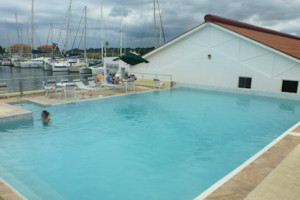
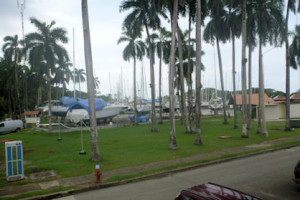
The pool at Shelter Bay Dry storage facility
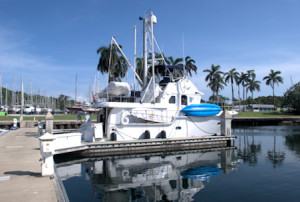
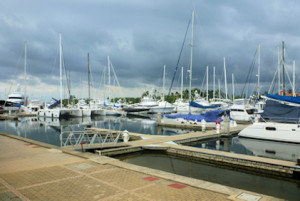
Tropical Blend at Shelter Bay Thunderstorm approaching the docks
Selling Blender Boy
Before we purchased Tropical Blend, we had owned express cruisers in the California Delta that we used almost every weekend during the long cruising season. Our last boat was the Blender Boy, a 38’ Sea Ray Sundancer. Once we had moved Tropical Blend to Alameda, we listed Blender Boy for sale. We didn’t get much action, and we had lowered the price several times. When we were at BYC, our broker called to tell us that we suddenly had two offers. Both were below asking price, which we had already significantly reduced, so we countered both of them with a current sales price, and one buyer agreed. Before we left California, we granted Power of Attorney to a good friend of mine so he could sign any documents when we were out of the country. However, we now found out there was a technical error with the PoA, and he could not sign the sales paperwork. We talked it over with our broker, and we decided that we could sign the documents with a notary in Panama. The easiest way would be to go to the US Embassy, but I found out that you had to make a specific appointment for notary service, and we would have to get from Colon to Panama City to do this – not too convenient. I asked our broke to see if the title service would accept a Panamanian notary, and they said yes.
While we were crossing the canal, the sea trial and surveys were completed. There were a few survey items we agreed to, and we had a final price and closing date. Now we had to find a notary in Colon. The marina recommends an ex-pat called Teddy to take you to Colon to the free zone for shopping, or to the Panama City airport. I called Teddy, and told him what we needed to do. He said that he knew a notary service in Colon, and that he could translate for us. A couple of days after we arrived at Shelter Bay, he took us to the notary. It took a really long time, and there was some discussion about Teddy’s role in this, as if he couldn’t legally translate for us, since he wasn’t a certified translator. $10 took care of that problem, and we got the notarized document. Teddy showed us around the town, and explained the Free Zone (Zona Libra) to us. It’s mostly for cruise ship passengers. As a tourist off the street, you aren’t allowed to go into the zone, although a small propina (tip / bribe) may get you in. Also, and goods purchased must be delivered separately to your boat, and customs officers come along to ensure that the goods are purchased by foreigners. This may cost up to $200. Teddy told us that he had a license to take tourists into the zone, and that he could get the goods out without having to pay any extra fees. We decided to take him up on this once Pete and Mary crossed over.
Our next task was to mail the documents back to California. Teddy took us to a DHL office, but they said they couldn’t ship the documents to California. What? Right next door was a Mailboxes Etc., where they could ship it via UPS with no problem. But it was expensive, at $60. Well, whatever. We finally sold our old friend, and were relieved to no longer be shelling out the slip fees and property taxes. Now we had no remaining ties to California, other than our small storage room in Merced.
The Great Battery Snafu
We knew that our batteries were in pretty bad shape – they didn’t hold a charge very long, and we suspected that reduced capacity was the problem with the bow thruster. After the difficulties at La Case de las Baterias, we decided to order new batteries from Marine Warehouse in Florida – they have an office in Panama. We would also order a new 30A shore power cord (one of ours was pretty chewed up) and a new bow thruster main switch (for $450!). On the DC electrical schematic for the boat, there are five 8D house batteries shown: four in the lazarette, and one in the forward cabin, near the bow thruster. I only saw two house batteries in the lazarette, with two storage boxes behind them on the starboard side. The batteries come with two types of terminals – a blade where the cables are bolted, or a round, automotive type. I took a quick look at the terminals on the bow thruster battery, which had the round plastic covers typically used for automotive posts, so I assumed that the posts were round. I ordered the three batteries, which are shipped via ocean freight for a reasonable charge. They would arrive towards the end of June.
Knowing that I couldn’t possibly lift and replace the 175 pound batteries, I asked the marina yard to arrange for some workers. I found out that they had recently contracted with a boater from San Francisco who used to work in California as a marine electrician. I decided to hire him to install the new bow thruster switch and hook up the batteries, and use the yard for heavy lifting labor. The batteries arrived pretty much on schedule, and the deliver crew brought them on to the boat. For some reason at that time, I took another look at the terminals, and discovered that they actually had the blade terminals – a major Homer Simpson D’oh! I asked the electrician Scott if he could install adaptors, and he thought this was very doable. He came on board to have a look, and he asked me about the “storage boxes” I had seen in the lazarette. Well, they were actually the other two 8D batteries. Once again, I had to scream D’oh! And admit that I was a moron. Since it is important that all batteries in the bank have the same age, we decided to hold off installing them until I got two more batteries (this time with the proper blade terminals). He did install the new bow thruster switch, which did not solve the problem, pointing to battery capacity as the culprit.
Life at Shelter Bay
We settled into life at Shelter Bay. This being Panama, and being the rainy season (when doesn’t it rain in Panama?), we had a lot of rain. It mostly came at night, with the occasional afternoon thundershower. Sometimes the lightning would hit very close to the marina. Once we determined that lightning was within a mile, we would gather up all of the portable electronic devices and stuff them into the stove, as a makeshift Faraday cage. Once night we were watching a storm pass over the canal, and the lightning strikes and thunder were simultaneous. At the end of our dock there was a beautiful 75’ sailing catamaran. Two crew were staying on the boat for the summer, and it was the first boat for the owners. The next day we found out just how close the lightning was: it struck the big cat, and bounced off to strike the monohull in the next berth. The damage was so severe the engines couldn’t be started – all their electronics got fried. Fortunately, they had good insurance, and everything was to be replaced. The mast had to be pulled, and once morning we watched in amazement as Victor, the yard manager, towed the huge catam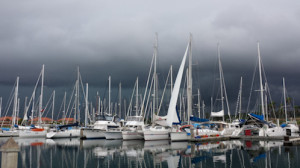 aran with his dinghy, in reverse. Lightning is the one thing that really scares us – there is really nothing you can do to totally protect yourself. We later found out that our friends on Second Wind got hit in Costa Rica, and their insurance company (the same one we have) paid for everything. At least we had that much security.
aran with his dinghy, in reverse. Lightning is the one thing that really scares us – there is really nothing you can do to totally protect yourself. We later found out that our friends on Second Wind got hit in Costa Rica, and their insurance company (the same one we have) paid for everything. At least we had that much security.
This bad-looking storm didn’t drop any rain on us
From time to time, we had some jellyfish in the marina – really big ones.
Water, water everywhere (but not always from the hose)
Usually the day after a big storm, the water pressure would be non-existent. That usually happened on days when we needed pressure for one reason or another. The frequent rain also exposed some leaks on our boat, mostly around the windows. We could see that the caulking on the superstructure was missing and moldy in many places, so we took on the tedious job of digging out the old caulk and re-doing it. The storage locker underneath the flying bridge instruments was really leaking, and we had a lot of mold and mildew on the items stored there. Water had leaked through the hatch doors, as well as around the instruments. One of the worst leaks was the cabin porthole on the starboard side of the salon. We figured out that it was leaking badly when we found water accumulating on the surface below the window. We completely pulled out the window, put a lot of epoxy resin into the wood around the frame, and carefully re-caulked it, to eliminate the leak. We also found that water was coming down around the smokestack. We weren’t sure where it was getting in, but we re-caulked everywhere we could think of, and put a drip-pan underneath the stack so the water wouldn’t spill into the engine room. Rosé worked very hard trying to stop the various leaks.
Neko finally escapes from the Balboa Yacht Club
After spending a month in a futile pursuit trying to get their dagger board repaired, Neko threw in the towel and decided to come over to Shelter Bay. They had previously been told that there were no lifts in Panama that could haul their boat out (with a 26’ beam), but now Shelter Bay was telling them it could be hauled out. So, they decided to quit BYC and transit the canal. They didn’t use an agent, but had no problems – it seems that the process has been simplified now to filling out forms online and paying a one-time fee at a simple bank. Anyway, we followed their transit, and captured some screen shots for them. They had the same issues that we did, with delays almost forcing them into a two-day passage, but they made it. We went out to the arrival dock and helped them to tie up, cracked a bottle of champagne, and joined them for a festive dinner at the Shelter Bay restaurant – bienvenidos, Neko! If you are interested in reading about the incredible saga of their dagger board, check out their website.




